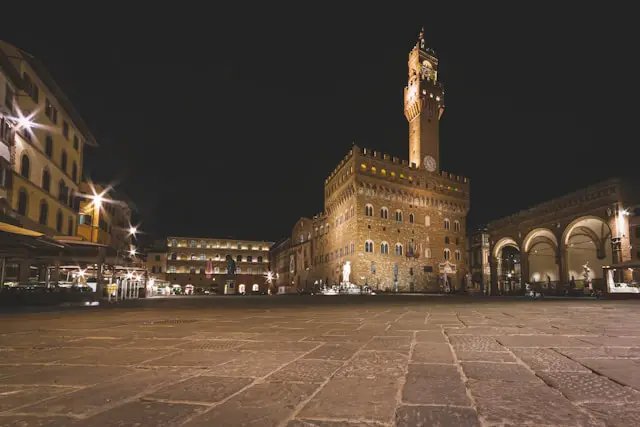
Renaissance architecture is known for its grandeur, elegance, and harmony.
It emerged in Italy during the 14th century and spread throughout Europe, leaving an indelible mark on architectural history.
In this blog post, we’ll explore some of the most famous Renaissance architectures across Italy and beyond.
Key Characteristics of Renaissance Architecture
Renaissance architecture, renowned for its distinctive features, is characterized by several key elements that collectively define its aesthetic and structural principles.
Emphasis on symmetry
Renaissance architects placed a profound emphasis on symmetry, seeking balance and proportion in their designs.
Buildings were often meticulously planned and executed to achieve a harmonious distribution of elements on either side of a central axis.
This commitment to symmetry not only appealed to a sense of visual order but also reflected the Renaissance ideals of proportion and perfection.
- Read also: Renaissance Art Versus Medieval Art
- Read also: Exploring Italian Renaissance Sculptures
Harmony
Harmony is a fundamental characteristic of Renaissance architecture, extending beyond mere symmetry.
Architects aimed to create a seamless integration of various architectural elements, such as columns, arches, and facades, into a unified and cohesive whole.
This pursuit of harmony was influenced by a desire to evoke a sense of grace and beauty inspired by the classical ideals of ancient Greece and Rome.
Classical elements
Renaissance architecture drew inspiration from classical antiquity, specifically the architectural styles of ancient Greece and Rome.
Architects incorporated classical elements such as columns, pilasters, and pediments into their designs.
The revival of classical forms was a deliberate move to reconnect with the perceived elegance and orderliness of antiquity, marking a departure from the medieval styles that preceded it.
Mathematical principles
Mathematical precision played a significant role in Renaissance architecture.
Architects applied geometric principles and mathematical ratios to achieve the desired proportions and spatial relationships in their designs.
This mathematical approach was not only a technical consideration but also a philosophical one, reflecting the Renaissance belief in the inherent order and rationality of the natural world.
Famous Renaissance Architectures Across Italy

Florence
Duomo of Florence
The Duomo of Florence, also known as the Cathedral of Santa Maria del Fiore, is one of the most iconic buildings in Florence.
Its dome, designed by Filippo Brunelleschi, was a revolutionary feat of engineering and remains the largest brick dome ever constructed.
Palazzo Medici Riccardi
The Palazzo Medici Riccardi, designed by Michelozzo di Bartolomeo, was one of the first Renaissance palaces in Florence.
Its design influenced urban planning in Florence and beyond, with its emphasis on symmetry and proportion.
Basilica of Santa Maria Novella
The Basilica of Santa Maria Novella, designed by Leon Battista Alberti, is known for its harmonious facade and use of classical elements like columns and arches.
Rome
St. Peter’s Basilica
St. Peter’s Basilica, designed by a team of architects including Michelangelo, Bramante, and Bernini, is one of the most iconic buildings in Rome.
Its dome, designed by Michelangelo, is a masterpiece of engineering and remains one of the largest in the world.
The Colosseum
The Colosseum, originally built in the 1st century AD, was repurposed during the Renaissance as a symbol of the city’s grandeur and power.
Its iconic arches and columns have inspired architects for centuries.
Trevi Fountain
The Trevi Fountain, designed by Nicola Salvi, is known for its playful blend of sculpture and architecture.
Its intricate design incorporates classical elements like columns and arches, as well as playful sculptures of sea creatures and mythological figures.
Venice
Doge’s Palace
The Doge’s Palace, designed by a team of architects including Giovanni and Bartolomeo Bon, is a masterpiece of Venetian architecture.
Its intricate facade incorporates Gothic and Renaissance elements, and its interior is adorned with stunning works of art.
Basilica di San Giorgio Maggiore
The Basilica di San Giorgio Maggiore, designed by Andrea Palladio, is known for its mastery of proportion and use of classical elements like columns and arches.
Its facade is a masterpiece of Renaissance architecture.
Rialto Bridge
The Rialto Bridge, designed by Antonio da Ponte, is known for its unique blend of function and aesthetics.
Its elegant arches and intricate design make it one of the most iconic bridges in Venice.

Renaissance Architecture Outside Italy
While Renaissance architecture is most closely associated with Italy, its influence can be seen throughout Europe and beyond.
Here are a few examples:
Château de Chambord in France
The Château de Chambord, designed by Domenico da Cortona, is known for its grand scale and intricate design.
Its facade incorporates classical elements like columns and arches, as well as playful sculptures of animals and mythological figures.
Hampton Court Palace in England
Hampton Court Palace, designed by a team of architects including Christopher Wren, is known for its fusion of Tudor and Renaissance styles.
Its intricate design incorporates classical elements like columns and arches, as well as Tudor-style chimneys and gables.
El Escorial in Spain
El Escorial, designed by Juan Bautista de Toledo and Juan de Herrera, is known for its blend of religious and political purpose.
Its design incorporates classical elements like columns and arches, as well as religious symbols and iconography.
Legacy and Inspiration
Renaissance architecture has left an indelible mark, evident in a myriad of buildings worldwide.
Its design principles, characterized by harmony, proportion, and classical elements, have inspired structures ranging from historic palaces and cathedrals to contemporary skyscrapers.
The legacy of Renaissance architecture is a global tapestry woven into the facades of grand buildings and soaring structures.
Its principles, rooted in a revival of classical ideals, continue to shape the visual language of architecture.

- Read also: The Rise and Fall of the Roman Empire
- Read also: Legendary Heroes of the Arena: Famous Roman Gladiators
Conclusion
Renaissance architecture is renowned for its grandeur, elegance, and the meticulous balance it achieves.
With a dedicated emphasis on symmetry, proportion, and the incorporation of classical elements such as columns and arches, this architectural style has served as a timeless inspiration for designers across the centuries.
The iconic structures in Florence and Rome, along with the opulent palaces in France and England, stand as testaments to the enduring legacy of Renaissance architectural principles.
Indeed, the influence of this aesthetic can be observed in diverse buildings across the globe, reflecting a harmonious blend of artistic vision and structural prowess.
FAQs
Renaissance architecture is a style of architecture that emerged in Italy during the 14th century and spread throughout Europe.
Some famous examples of Renaissance architecture include the Duomo of Florence, St. Peter’s Basilica in Rome, and the Doge’s Palace in Venice.
The legacy of Renaissance architecture can be seen in the many buildings and structures that have been inspired by its design principles.


